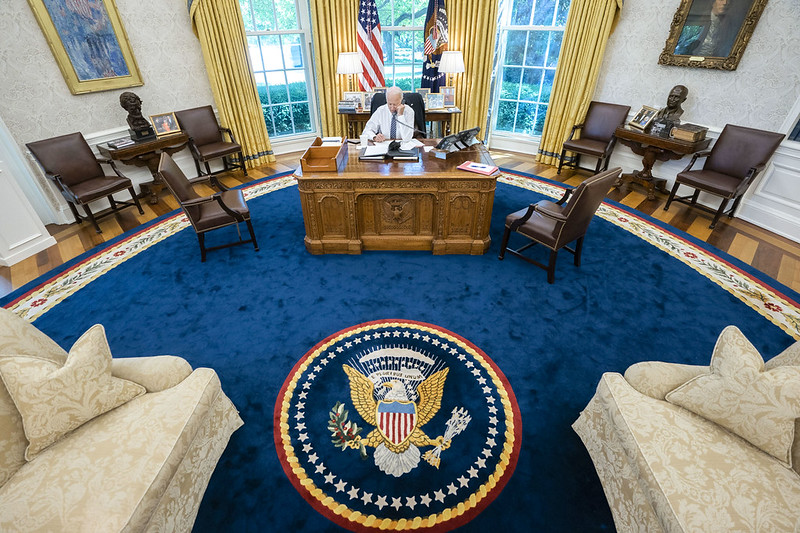The New Eviction Moratorium Didn't Result From a Screw-Up
A response to Jack Goldsmith.

Published by The Lawfare Institute
in Cooperation With

Jack Goldsmith has written a detailed critique of the Biden administration’s legal actions in response to the impending end and subsequent renewal of the eviction moratorium at the end of July. Goldsmith opens his post, titled “The Anatomy of a Screw Up: The Biden Eviction Moratorium Saga,” with the statement “It is hard to fathom how the experienced policy advisers and lawyers atop the Biden administration could have screwed up so badly.” Goldsmith goes on to write that the “administration’s rule-of-law credibility is the big loser.” After the past four years of rule-of-law challenges, that is a powerful condemnation. The Lawfare podcast covering Goldsmith’s post and one by another Lawfare editor is even more brutally entitled “A Moratorium Fiasco.” While Goldsmith’s piece ultimately defends the lawfulness of the administration’s actions extending a narrower version of the moratorium, he is highly critical of the process that got the administration to the narrower version.
Goldsmith’s piece makes assumptions about the executive branch process that may well not be accurate and downplays the practical impact of very clear signals from the Supreme Court, as well as that of the administration’s attempt to explain a complicated procedural posture into everyday language. I was White House counsel for the last three years of the Obama administration. The current White House counsel, Dana Remus, was my ethics deputy, where she served with distinction for more than over two years. I have not spoken to Remus or anyone involved in the process, but I have made what I believe to be reasonable inferences about the process based on the reporting I have read and my experience serving in the White House. Here, I offer some thoughts on Goldsmith’s piece and about the administration’s handling of the situation.
Goldsmith draws from public remarks given by officials within the administration. His post cites comments in late July and early August from the president, White House press secretary Jen Psaki, and White House coordinator Gene Sperling that extending the moratorium on the basis of the existing Centers for Disease Control and Prevention (CDC) order would be in excess of the agency’s statutory authority. Those comments all referenced the Supreme Court’s June 29 order refusing to stop the previous eviction moratorium. Without comment, four justices (Chief Justice John Roberts and Justices Stephen Breyer, Sonia Sotomayor and Elena Kagan) would have kept the moratorium in place; four justices (Justices Clarence Thomas, Samuel Alito, Neil Gorsuch and Amy Coney Barrett) indicated they would have vacated the lower court order keeping the moratorium in place; and Justice Brett Kavanaugh wrote in a single paragraph that the CDC “exceeded its existing statutory authority by issuing a nationwide eviction moratorium” but that, with so little time left before the moratorium would end by its own terms on July 31, he would not intervene. Any reasonable lawyer would read the result of this Supreme Court lineup as follows: the court will not permit the then-formulated eviction moratorium to continue after July 31. Kavanaugh was explicit in that position in his one-paragraph opinion, and there is no reason to think the other four justices would change their votes.
Goldsmith’s piece emphasizes that the “technical conclusion” of the court’s actions merely declined to vacate the district court stay but did not, as some commentators have argued, hold that the ban ending on July 31 was unlawful. His position is accurate. There was no decision on the merits. But Goldsmith then goes a step further, arguing that “there is a broader reason not to read more into the court’s order.” He seems to argue that the administration over-read what the Supreme Court meant by this order on the “shadow docket” because the only action the order actually accomplished was to permit the moratorium to continue in place. That position, however, underestimates the import of the breakdown of votes and Kavanaugh’s 31-more-days-but-no-more paragraph.
As White House counsel, I was frequently called upon to predict how the courts would react to a proposed administration initiative. An initiative that is stayed by the courts and ultimately set aside is not effective. In this case, such an initiative would fail to provide full relief to distressed renters and could potentially place other public health and economic recovery measures in jeopardy as the Delta variant of the coronavirus surges. This means that as the White House lawyers evaluated the issues, they had to consider where the Supreme Court could fall on other coronavirus initiatives that the administration and the states might wish to pursue. In light of the position of Kavanaugh, who on this new Supreme Court has become the most reliable swing vote (voting with the majority in divided cases 87 percent of the time), administration lawyers could have quite rationally concluded that an order simply extending the existing moratorium would be quickly set aside. Briefing on the merits and oral argument would have given the administration an opportunity to advocate for its legality more thoroughly. But it was pretty clear after the June 29 order that the Supreme Court would likely stay the moratorium pending briefing and argument on the merits. The position on the merits that mattered—Kavanaugh’s—had been communicated: The moratorium exceeded the CDC’s authority. In Kavanaugh’s view, “clear and specific congressional authorization (via new legislation) would be necessary for the CDC to extend the moratorium past July 31.” Precluding the moratorium from continuing during the time in which the matter was briefed, argued and decided would not have provided the millions of renters with the relief the administration wanted to give them, even if the administration ultimately won on the merits. I agree with Goldsmith that the court did not strike down the moratorium, but the court made clear enough that if the same issue came back, it would.
Goldsmith rightly points out that “a confident prediction is not a legal ruling.” True, but White House counsels, and administrations, have to deal with reality, not abstract legal issues. At the core of the reality here lay questions that will determine whether millions of renters will be evicted from their homes during a pandemic. That is the context in which the White House lawyers were giving their advice. Predictions about how courts are likely to act certainly inform the advice administration lawyers give and how they communicate the consequences of these rulings in public. Goldsmith’s argument that the June 29 order was impenetrable except insofar as it upheld the moratorium is simplistic. Unlike Kavanaugh, the other eight justices did not write about how they came to their conclusions. But given the lineup, it was a safe assumption that if the same moratorium came back to the court, they would all vote the same way, which would have the effect of striking down the moratorium. The administration charted a course, although likely not its preferred course, accordingly.
Although Goldsmith posits several potential options for how to handle the moratorium, the two of us agree that the only safe path that would settle the issue would have been for Congress to amend the statute to provide for clear authority in the CDC. Every other path, as the White House lawyers no doubt recognized, would leave the fate of the administration’s efforts in the courts. An administration strategy to put maximum pressure on Congress to pass legislation clearly establishing that the CDC has this authority seems prudent. The need for action is enormous, the risk to renters is monumental, and only Congress can provide the type of remedy that is largely litigation proof.
There’s also the question of the statements made by various administration officials. Goldsmith criticizes all three of the administration speakers, including the president, for overstating what the Supreme Court had actually decided in the June 29 order. In my view, this was a law professor’s criticism, not a real-world criticism. When asked about extending the moratorium, with the goal of getting Congress to act in mind, White House press secretary Jen Psaki said: “Unfortunately, the Supreme Court has made clear that this option is no longer available.” Goldsmith’s main criticism of this comment comes from her saying “the ruling stated”—a technical matter. Of course, she meant the “ruling signaled.” Later, White House coordinator Gene Sperling said: “Unfortunately, the Supreme Court declared on June 29 that the [CDC] could not grant such an extension without clear and specific congressional authorization.” Again, yes, it was only Kavanaugh who stated this, but his is the vote that mattered in this context, and that technicality did not, in the administration’s mind, change the practical import of Kavanaugh’s signposting. Kavanaugh’s view on this matter would likely end up being the court’s if the moratorium boomeranged back.
The president, in a separate statement, included a long paragraph about soliciting advice from constitutional law scholars. The statement comments that “the Court has already ruled on the present eviction moratorium.” Sperling, in his own comments, also said that the CDC had been unable to find legal authority for a new mandate “to date,” signaling at least a possibility of change down the road.
While in law school, professors teach students the difference between holdings and dicta; between what the court is holding in a particular case and signposting for future litigants. People who work for the executive branch in a communications capacity have the job of turning this complicated legal, procedural jargon into something all Americans can understand. Statements from the White House podium can almost always benefit from more nuance. I read the statements by the president, Psaki, and Sperling as being aimed at clearly telling Congress that if it wants a solid extension of the existing moratorium, then it must act immediately. In my view, in light of the Supreme Court’s June 29 order, that position seems correct. In short, Goldsmith’s criticism of the president and administration officials seems to be that they were telling the public what they believed to be the practical effect of the court’s order rather than what law schools teach as a “holding.” Despite Goldsmith’s assertions, I fail to see how this amounts to the administration’s rule-of-law credibility being a big loser.
The Goldsmith post also appears to suggest that the White House counsel was deficient in failing to adequately brief the president and Psaki before each made their statements about the June 29 order. I very much doubt that his characterization is accurate. First, it seems to me that an accurate reading of the June 29 order is that the justices had already plainly notified the administration of how a simple renewal of the existing eviction moratorium would fare. The four justices who voted to strike down the moratorium would certainly vote the same way, and Kavanaugh had already made plain that an extension beyond July 31 would not garner his approval. Second, Psaki was director of communications when I was at the White House; I know her as careful and precise, and I have confidence she would have sought and obtained input from the White House Counsel’s Office before taking a position from the podium on the administration’s legal position. The same goes for statements the president made, which should be put in the context of his preference to speak to the American people in plain English rather than through the formalities of legal jargon. It could be argued that pressure on Congress to take action had a low chance of success, but it was the only option that offered a relatively certain outcome to benefit those renters facing immediate eviction and all the disruption of their lives that process entails. I very much doubt that the statements by the president and Psaki were a result of failure of communication between them and the White House Counsel but, instead, were products of a political strategy and stylistic preference.
An administration does not get to operate based solely on legal theories and must deal with reality, including changing political realities. Speaker of the House Nancy Pelosi did not have the votes to grant the CDC explicit statutory authority. She told the administration that Congress would not take up the issue, putting the ball back in the administration’s court. When the plan to encourage Congress to address the issue failed, administration lawyers did what so often happens at the highest levels of government: Circumstances change quickly, initiatives stall in Congress, and adaptations to original plans must be made. It appears that, consistent with their statements to date, the administration lawyers acknowledged that a simple continuation of the nationwide eviction moratorium was unlikely to survive in the courts and might even be enjoined immediately. White House lawyers have to rely on their best predictions as they formulate how to keep worthwhile policies in place despite attacks in the courts.
As discussed above, the lawyers had only the one-paragraph Kavanaugh statement from the June 29 order and the knowledge that a hallmark of this new Supreme Court has been the insistence on narrow tailoring of remedies to address an issue. Likely the swing vote on the issue, Kavanaugh had specifically concluded that a nationwide moratorium was unlawful. With the issue now back in its lap following Pelosi’s announcement—and with the prospect of mass evictions on the horizon—administration lawyers backed a new eviction moratorium tailored to where the need was the greatest, even though it had not been their legal strategy “to date,” as Sperling noted. The new moratorium is currently being litigated in the courts—narrower than the one in effect before Aug. 1. Despite the palace-intrigue valence of many of the analyses surrounding the new moratorium, I find these actions to be typical of administration lawyers adapting quickly to changing circumstances in a highly charged atmosphere, and one where they were desperate to bring relief to millions of renters if they could legally find a way.
Two other aspects of Goldsmith’s post seem worthy of discussion here. First, he notes the uncertain role of the Department of Justice in the whole process. I find it not at all strange that the department’s role has not been the subject of press reports. What is more surprising, in an administration that has had few leaks, is how much of the internal process has been disclosed through reporting. I am certain there will have been informal discussions with the department—as there were during my tenure as White House counsel—about the position the administration would take and that those discussions evolved with changing circumstances. These discussions are usually not reduced to memoranda and rarely involve a formal Office of Legal Counsel (OLC) opinion. The lack of reporting or release of a formal OLC opinion does not establish that the Justice Department was not consulted, and I very much doubt that the lawyers there were out of the loop.
Second, there is a suggestion in Goldsmith’s piece that the involvement of Laurence Tribe, Martha Minow, and Walter Dellinger was somehow improper or coerced by Pelosi. I do not agree with that suggestion at all. While working as White House counsel, I regularly spoke with outside lawyers, particularly law professors, about difficult legal issues. I wanted the best possible legal thinking from a variety of sources. On certain issues, such as national security law, immigration, and constitutional law, I had different “kitchen cabinets” that I consulted regularly. Among those law professors I consulted was Dellinger, just as he appears to have been consulted by the White House lawyers here. There were excellent lawyers at the department and in my own office, but I valued outside input as well. I found it helpful, particularly in evaluating creative ideas and especially as important pieces of the landscape changed quickly, as happened here.
Certainly, as the press has reported on these issues and as the political narrative unfolded, aspects of the process might appear jarring from the outside. Read from the vantage point of a former White House counsel, I see my successor, Dana Remus, her office and the Justice Department reacting quickly as circumstances shifted and coming up with a defensible policy that should help millions of the most vulnerable Americans.





